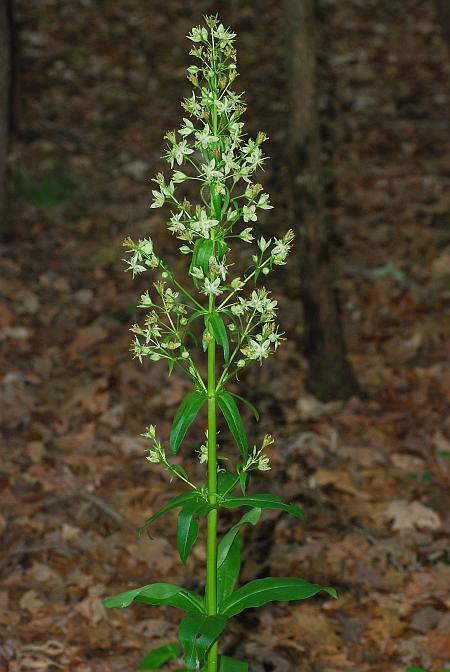Frasera caroliniensis Walter
American Columbo

Native
CC = 7
CW = 5
MOC = 17
© SRTurner
Frasera caroliniensis WalterAmerican Columbo | |
 |
Native CC = 7 CW = 5 MOC = 17 |
© SRTurner |
|
Family - Gentianaceae Habit - Perennial, monocarpic forb, producing an aerial stem only at the onset of floral development. Leaf - Basal rosettes present prior to flowering. Cauline leaves whorled in groups of 4-5, 10-20 cm long, becoming progressively smaller upward, grading into linear bracts in inflorescence.
Stem - Flowering stem erect, to 2.5 m, thick, hollow, glabrous, green to purplish.
Inflorescence - Appearing as large, conic or conic-elliptic, highly branched panicle. Consists of numerous smaller, mostly axillary panicles.
Calyx - Calyces lobed nearly to base, the lobes linear-lanceolate, 6-10 mm long.
Flower - Tetramerous. Corollas greenish yellow to nearly white, purple-dotted, deeply lobed, the lobes 10-14 mm long, each lobe bearing a large, fringed, purple nectary gland near the middle of the upper surface. Filaments of stamens elongate, connate at base. Ovaries ovoid, the style elongate, persistent in fruit, the stigma capitate, 2-lobed.
Fruits - Ovoid capsules 15-25 mm long, longitudinally dehiscent.
Flowering - May - July. Habitat - Forests, glades, bases of bluffs, streambanks. Origin - Native to the U.S. Lookalikes - None when flowering. Vegetative rosettes can be mistaken for those of Cynoglossum or Veratrum. Other info. - Here is a species which is easy to identify and impossible to miss, due to the tall, showy inflorescences. Even when vegetative the plant can be readily recognized by its distinctive, light green basal rosettes, which are distinguished from those of Cynoglossum by virtue of being glabrous. It is always a treat to encounter flowering specimens while strolling in the woods in late spring. The flowers are beautiful and interesting in detail, with large, fringed nectary glands on the petal surfaces. These attract a wild profusion of bumblebees, ants, and other insects. The plant's range in Missouri is mostly restricted to the southeastern quadrant of the state. Beyond Missouri it is mostly found in the U.S. Midwest. Photographs taken at Crowley's Ridge Conservation Area, Stoddard County, MO, 3-29-2000, Valley View Glade Natural Area, Jefferson County, MO, 5-18-2010 and 5-24-2010, St. Joe State Park, St. Francois County, MO, 5-14-2012, S0haw Nature Reserve, Franklin County, MO, 6-05-2014, 7-17-2018, and 7-22-2020 (SRTurner); also at unrecorded site in Missouri, 3-29-2000 (JRAbbott). |